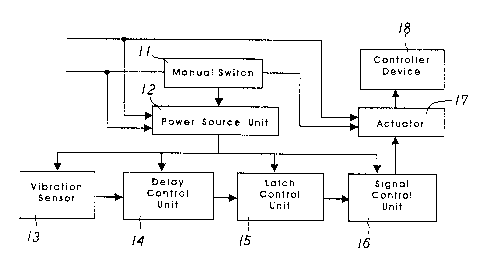Some of the information on this Web page has been provided by external sources. The Government of Canada is not responsible for the accuracy, reliability or currency of the information supplied by external sources. Users wishing to rely upon this information should consult directly with the source of the information. Content provided by external sources is not subject to official languages, privacy and accessibility requirements.
Any discrepancies in the text and image of the Claims and Abstract are due to differing posting times. Text of the Claims and Abstract are posted:
| (12) Patent Application: | (11) CA 2343472 |
|---|---|
| (54) English Title: | VIBRATION SENSING ASSEMBLY |
| (54) French Title: | CAPTEUR DE VIBRATIONS |
| Status: | Deemed Abandoned and Beyond the Period of Reinstatement - Pending Response to Notice of Disregarded Communication |
| (51) International Patent Classification (IPC): |
|
|---|---|
| (72) Inventors : |
|
| (73) Owners : |
|
| (71) Applicants : |
|
| (74) Agent: | SMART & BIGGAR LP |
| (74) Associate agent: | |
| (45) Issued: | |
| (22) Filed Date: | 2001-04-05 |
| (41) Open to Public Inspection: | 2002-10-05 |
| Examination requested: | 2001-10-05 |
| Availability of licence: | N/A |
| Dedicated to the Public: | N/A |
| (25) Language of filing: | English |
| Patent Cooperation Treaty (PCT): | No |
|---|
| (30) Application Priority Data: | None |
|---|
A vibration sensing assembly is provided which is
used as a vibration control switch while a user contacts the
vibration sensing assembly. The assembly has a manual power
switch, a power unit source, a vibration sensor, a delay
control unit, a latch control unit, a signal control unit, an
actuator and a controlled device. A vibration sensing assembly
comprising a manual switch, a power source unit, a vibration
sensor, a delay control unit, a latch control unit, a signal
control unit, an actuator, and a controlled device,
characterized in that the manual switch is connected to the
power source unit. The power source unit is connected to the
vibration sensor, the delay control unit, the latch control
unit, and the signal control unit. The delay control unit is
connected to the vibration sensor and the latch control unit.
The signal control unit is connected to the latch control unit
and the actuator. The actuator is connected to the controlled
device. The vibration sensor sends an unstable signal to the
delay control unit. The delay control unit delays the time
period of the unstable signal and sends the unstable signal to
the latch control unit. The latch control unit converts the
unstable signal into a stable signal and sends the stable
signal to the signal control unit. The signal control unit
sends the stable signal to the actuator. The actuator drives
the controlled device to operate.
Note: Claims are shown in the official language in which they were submitted.
Note: Descriptions are shown in the official language in which they were submitted.

2024-08-01:As part of the Next Generation Patents (NGP) transition, the Canadian Patents Database (CPD) now contains a more detailed Event History, which replicates the Event Log of our new back-office solution.
Please note that "Inactive:" events refers to events no longer in use in our new back-office solution.
For a clearer understanding of the status of the application/patent presented on this page, the site Disclaimer , as well as the definitions for Patent , Event History , Maintenance Fee and Payment History should be consulted.
| Description | Date |
|---|---|
| Inactive: IPC from MCD | 2006-03-12 |
| Application Not Reinstated by Deadline | 2004-03-01 |
| Inactive: Dead - No reply to s.30(2) Rules requisition | 2004-03-01 |
| Deemed Abandoned - Failure to Respond to Maintenance Fee Notice | 2003-04-07 |
| Inactive: Abandoned - No reply to s.30(2) Rules requisition | 2003-02-28 |
| Application Published (Open to Public Inspection) | 2002-10-05 |
| Inactive: Cover page published | 2002-10-04 |
| Inactive: S.30(2) Rules - Examiner requisition | 2002-08-30 |
| Letter Sent | 2001-11-07 |
| Inactive: Entity size changed | 2001-11-07 |
| Request for Examination Requirements Determined Compliant | 2001-10-05 |
| All Requirements for Examination Determined Compliant | 2001-10-05 |
| Request for Examination Received | 2001-10-05 |
| Inactive: First IPC assigned | 2001-05-25 |
| Inactive: Filing certificate - No RFE (English) | 2001-05-09 |
| Application Received - Regular National | 2001-05-09 |
| Abandonment Date | Reason | Reinstatement Date |
|---|---|---|
| 2003-04-07 |
| Fee Type | Anniversary Year | Due Date | Paid Date |
|---|---|---|---|
| Application fee - small | 2001-04-05 | ||
| Request for examination - standard | 2001-10-05 |
Note: Records showing the ownership history in alphabetical order.
| Current Owners on Record |
|---|
| JUNG-TSUNG WEI |
| Past Owners on Record |
|---|
| None |